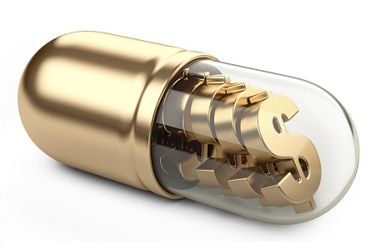Gilead Saves Lives And Healthcare Dollars By Taking Profits
By Louis Garguilo, Chief Editor, Outsourced Pharma

Pity the inventor’s lot: He is the source of society’s enrichment but nobody likes what he does.
-- Matt Ridley quoted in “The Rational Optimist”
Or rather, it appears, nobody likes what he charges.
In part one we discussed how negative coverage of the drug Sovaldi and the company Gilead Sciences, Inc., is orchestrated and just plain wrong. It’s wrong in terms of measurement (price vs. value), economics (socialized vs. free markets), politics (short-term vs. long-term policies), and thus wrong for our entire society and global health care (less new drugs vs. more).
The Hepatitis C treatment based on Sovaldi (Sofosbuvir), which will help eradicate what was a growing global scourge, is priced fairly:
- It is affordable worldwide and saves billions of dollars in health care.
- It allows a profitable, free-market company to create more innovative drugs.
- It also validates the biotechnology model as an engine of new drug discovery.
Sovaldi Is Universally Affordable And Available
Paul Sidhu, VP, Global Custom Pharmaceutical Services, Hetero USA, Inc., says, “Pricing gets tested in a free marketplace. A drug’s full value has to be apparent to the patient and payor, or the drug will fail to be accepted at a certain price. To me personally, the incredible US sales uptake of Gilead’s Sovaldi demonstrates its clinical impact and economic value.” Sidhu adds parenthetically, “I still believe we have a free marketplace for healthcare in the U.S.”
 Some are less sanguine as to how free the U.S. healthcare market is or will remain. Expanding – as opposed to strategies to limit – access to market-priced innovative drugs needs to be better addressed in our healthcare system. And looking around the world, that access to new drugs transfers to those global markets with far less purchasing power.
Some are less sanguine as to how free the U.S. healthcare market is or will remain. Expanding – as opposed to strategies to limit – access to market-priced innovative drugs needs to be better addressed in our healthcare system. And looking around the world, that access to new drugs transfers to those global markets with far less purchasing power.
In fact, Gilead has already made Sovaldi available in developing countries. Remarkable in speed and scope, soon after market introduction in the U.S., Gilead announced licensing agreements with several India-based generic pharmaceutical manufacturers to expand access to “its chronic hepatitis C medicines in developing countries” at pricing for those markets. The agreements specifically allow the companies, including Sidhu’s Hetero, to manufacture “sofosbuvir and the investigational single tablet regimen of ledipasvir/sofosbuvir for distribution in 91 developing countries.”
“This is groundbreaking,” says Sidhu. “Hetero has already gained Indian government approval, and can offer Sofosbuvir in developing countries at a price affordable to patients there, allowing the same sort of access to important hepatitis-C treatment to those with less economic means.”
According to Gilead, countries covered by the agreement account for over 100 million people with hepatitis C, representing 54% of the total global infected population. “These agreements are essential to advancing the goals of our humanitarian program in these countries,” commented Gregg H. Alton, Executive Vice President, Corporate and Medical Affairs, Gilead Sciences.
If markets work freely, they allow drug companies to profit, continue to discover new treatments and cures, and indeed practice altruistic (market-adjusted) pricing for successful uptake in more economically challenged countries.
What’s impressive – and again a signature of free markets – is that Gilead has structured its agreement so that Hetero and all the companies under license will compete for market share, potentially further lowering prices.
What’s astounding, though, is that instead of lauding Gilead, there’s been negative reporting because the company requests some standards for patient identity is applied to drug distribution. With all the good in what Gilead is doing for the world, this is the type of storyline alteration of biopharmaceutical companies that is so unfortunate. It feels politically driven, economically naïve, and as we saw in part one of this article, harmful to our health care in the long run.
Cheap Is The Most Expensive Thing In Life
For years now, our society has been redolent with growing illusions of enduring entitlement, and the specious concept of “cheap.” According to Ellen Ruppel Shell in the 2009 bestseller, “Cheap: The High Cost of Discount Culture”:
“The economics of Cheap cramps innovation, contributes to the decline of once flourishing industries, and threatens our proud heritage of craftsmanship … The ennoblement of Cheap marks a radical departure in American culture, and a titanic shift in national priorities.”
Those national priorities today seem to increasingly include feeding citizens the idea they can get more of everything for less. For example, generics and biosimilars are heralded as “saviors” of national healthcare. The free-market participation (after IP expiration) of follow-on drugs is indeed important to healthcare systems and patients. Here are four articles I’ve written recently on the participation of generics and biosimilars in the U.S market. However, the point here is:
There are no generics or biosimilars without an original innovative drug to copy. There will be few if any innovative drugs without profitable companies that can invest billions of dollars in discovering, developing and manufacturing new drugs.
Instead of this basic understanding, the public is fed a subterfuge of cheaper prices as the savior of healthcare. If political savants and administrators of the “healthcare system” protest there are not enough dollars for new drugs, then they should immediately do at least the following: Move further towards – not farther from –free markets that result in more drugs and therapies, and adequately measure the money saved throughout the entire system. More innovative drugs and therapies at profitable pricing are a real patient and healthcare system benefactor.
The Biotech Drug Engine
According to John J. Castellani, president & CEO, Pharmaceutical Research & Manufacturers of America (PhRMA), “Biopharmaceutical companies consistently invest more in R&D than any other industry, accounting for approximately 20% of all domestic R&D funding by U.S. businesses. In 2013 alone, biopharmaceutical companies invested $51.1 billion in the search for new treatments and cures … A thriving community of innovators—including large and small biopharma and biotech companies—makes the research ecosystem that much healthier.”
Suggesting otherwise is disingenuous. Moreover, the symbiotic relationship that was once suspected among biotech and Big Pharma has now fully developed within free markets in the U.S., and elsewhere. Today it’s estimated Big Pharma uses an estimated 60% of drugs obtained from biotechs.
On the front-end, biotechs are funded by venture capital (VC). (And let’s be fair: also by the National Institutes of Health (NIH) and other government programs.) Capital investment is thus an important component in the discovery of new drugs. According to BioCentury, already in 2015 the Biotech industry has raised $17.7 billion from investors.
However, biotechs compete for investor funding with industries such as information technology. Can they continue to compete when the new Apple Watch is touted as providing some inherent consumer value at whatever price Apple can get for it, while a life-saving product like Sovaldi gets treated with such orchestrated animus? Is VC going to invest in IT or Bio if one is lauded for the highest profitability, but the other is treated in opposite fashion by government and powerful intermediaries pushing artificial price constraints? Sooner or later investment in biotechnology will stop. We’ll starve the goose that lays the golden drugs, if we don’t strangle him first with incomplete value assessments and price controls.
